Letzte Woche meldete sich einer unserer Besucher, weil seine XML-Sitemap in Yoast SEO einen 404-Fehler zurückgibt. Das erinnerte uns an unsere frühen WordPress-Tage, als wir auf das gleiche Problem stießen und online keine einfache Lösung finden konnten.
Seitdem haben wir mit WPBeginner Tausenden von WordPress Benutzern geholfen, und der Yoast-Sitemap-Fehler ist nach wie vor eines der häufigsten SEO-Probleme, die wir sehen. Obwohl es auf den ersten Blick technisch erscheinen mag, ist die Behebung dieses Fehlers tatsächlich einfacher, als Sie vielleicht denken.
Wir stellen Ihnen unsere getestete Lösung vor, die sich bei unzähligen WordPress Websites bewährt hat, auch bei unserer eigenen. Egal, ob Sie ein Anfänger oder ein erfahrener Benutzer sind, Sie werden in der Lage sein, diesen Fehler zu beheben und Ihre Sitemap in kürzester Zeit richtig zum Laufen zu bringen.
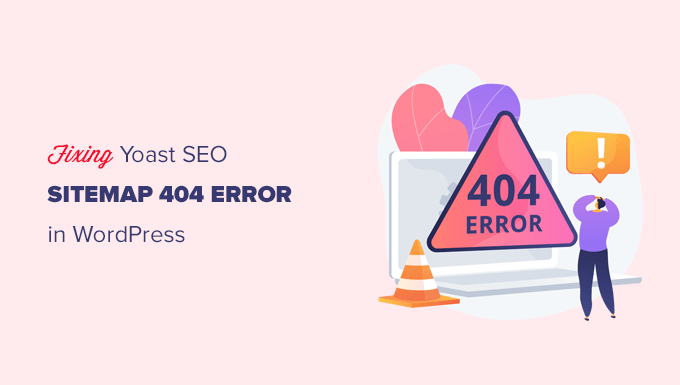
Was ist die Ursache Yoast SEO Sitemap 404 Fehler in WordPress?
Die Yoast SEO-Sitemap hilft Suchmaschinen, alle Inhalte auf Ihrer Website zu finden, die sie finden und indizieren sollen.
Durch die Behebung des Fehlers wird sichergestellt, dass Suchmaschinen auf Ihre Sitemap zugreifen und alle Seiten und Inhalte Ihrer Website finden können. Dies kann zu einer besseren Sichtbarkeit und Platzierung in den Suchmaschinen führen und hilft außerdem, Ihre Inhalte schneller zu platzieren als ohne eine Sitemap.
WordPress verfügt über eine Standard-XML-Sitemap, die Sie bei Google Search Console und anderen Suchmaschinen einreichen können.
Diese XML-Sitemap können Sie aufrufen, indem Sie die folgende URL in die Adresszeile Ihres Browsers eingeben:
https://example.com/sitemap.xml
Diese von WordPress standardmäßig erstellte Sitemap ist jedoch sehr einfach. Um dies zu beheben, erstellen alle führenden WordPress SEO Plugins wie Yoast SEO und das All in One SEO Plugin ihre eigenen XML-Sitemaps mit mehr Funktionen.
Wenn Sie die von Ihrem WordPress SEO Plugin generierte XML-Sitemap verwenden, schreibt das Plugin die Standard WordPress XML-Sitemap-Verknüpfung um.
Das bedeutet, dass die oben genannte URL der Sitemap die Benutzer zu den von Ihrem WordPress SEO Plugin generierten Sitemaps weiterleitet.
Leider kann dies auf manchen Websites aufgrund von Plugin-Konflikten oder falschen WordPress-Einstellungen zu einem 404-Fehler führen.
In den folgenden Abschnitten zeigen wir Ihnen, wie Sie den WordPress-Sitemap-404-Fehler im Yoast SEO Plugin ganz einfach beheben können. Hier finden Sie einen kurzen Überblick über alle Methoden, die wir behandeln werden:
Sind Sie bereit? Dann fangen wir gleich an.
1. WordPress Permalink-Struktur aktualisieren
WordPress verfügt über eine SEO-freundliche URL-Struktur, die Permalinks genannt wird. Diese URL-Struktur verwendet ein Umleitungssystem, um Ihrem Webhosting Server mitzuteilen, welche Seite geladen werden soll, wenn ein Benutzer eine URL in seinen Browser eingibt.
Normalerweise werden diese Permalinks-Einstellungen automatisch aktualisiert, wenn Sie Änderungen an Ihrer Website vornehmen.
Die schlechte Nachricht ist, dass WordPress manchmal nicht in der Lage ist, die Permalink-Struktur zu aktualisieren, was dazu führen kann, dass der Fehler “Sitemap 404” von Yoast SEO auftritt.
Dies lässt sich jedoch leicht beheben, indem Sie im WordPress-Administrationsbereich die Seite Einstellungen ” Permalinks aufrufen und einfach auf den Button “Änderungen speichern” klicken.
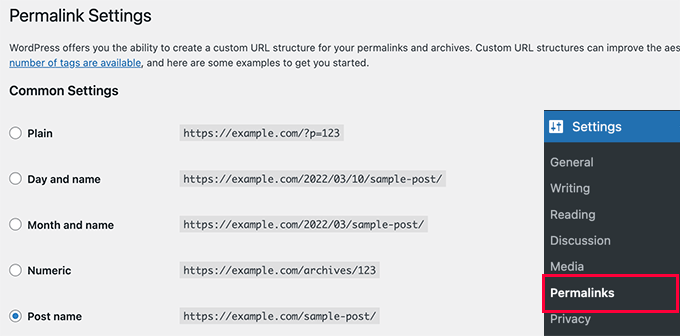
Dadurch werden die WordPress-Permalink-Einstellungen aktualisiert. Sie können nun Ihre XML-Sitemap-Seite besuchen, um zu sehen, ob Ihr Problem dadurch behoben wurde.
Wenn das Problem dadurch nicht behoben wurde, können Sie weiter lesen.
2. Permalinks manuell aktualisieren
Wenn die Aktualisierung Ihrer WordPress-Permalink-Struktur den 404-Fehler nicht behebt, können Sie Ihren Webserver manuell anweisen, die Benutzer auf die Sitemap-Seite von Yoast SEO umzuleiten.
Dazu müssen Sie den folgenden Code in Ihre .htaccess-Datei einfügen.
1 2 3 4 5 6 7 8 9 | # Yoast SEO - XML Sitemap Rewrite FixRewriteEngine OnRewriteBase /RewriteRule ^sitemap_index.xml$ /index.php?sitemap=1 [L]RewriteRule ^locations.kml$ /index.php?sitemap=wpseo_local_kml [L]RewriteRule ^geo_sitemap.xml$ /index.php?sitemap=geo [L]RewriteRule ^([^/]+?)-sitemap([0-9]+)?.xml$ /index.php?sitemap=$1&sitemap_n=$2 [L]RewriteRule ^([a-z]+)?-?sitemap.xsl$ /index.php?yoast-sitemap-xsl=$1 [L]# END Yoast SEO - XML Sitemap Rewrite Fix |
Hinweis: Wenn Ihre WordPress-Website in einem Unterverzeichnis oder Ordner (z. B. https://example. com/mywebsite/ ) installiert ist, müssen Sie den folgenden Code verwenden.
1 2 3 4 5 6 7 8 9 | # Yoast SEO - XML Sitemap Rewrite FixRewriteEngine OnRewriteBase /mywebsite/RewriteRule ^sitemap_index.xml$ /index.php?sitemap=1 [L]RewriteRule ^locations.kml$ /index.php?sitemap=wpseo_local_kml [L]RewriteRule ^geo_sitemap.xml$ /index.php?sitemap=geo [L]RewriteRule ^([^/]+?)-sitemap([0-9]+)?.xml$ /index.php?sitemap=$1&sitemap_n=$2 [L]RewriteRule ^([a-z]+)?-?sitemap.xsl$ /index.php?yoast-sitemap-xsl=$1 [L]# END Yoast SEO - XML Sitemap Rewrite Fix |
Vergessen Sie nicht, /mywebsite/ durch den Namen Ihres Unterverzeichnisses zu ersetzen.
Dieser Code teilt Ihrem Webserver einfach mit, welche Seiten angezeigt werden sollen, wenn Benutzer auf die XML-Sitemaps von Yoast SEO zugreifen.
Sie können nun versuchen, Ihre XML-Sitemap anzuzeigen, um zu sehen, ob Ihr Problem dadurch gelöst wird.
3. Wechseln Sie zu einem XML-Sitemap-Plugin
Wenn die oben genannten Methoden den 404-Fehler auf der XML-Sitemap-Seite von Yoast SEO nicht behoben haben, können Sie versuchen, ein separates Plugin zu verwenden, um XML-Sitemaps für Ihre Website zu erstellen. Ein gutes Plugin dafür ist das XML Sitemaps Plugin.
Der Nachteil dieses Ansatzes ist, dass Sie sich auf ein separates Plugin zur Erstellung von XML-Sitemaps und Yoast SEO für andere SEO-Funktionen verlassen müssen.
Zunächst müssen Sie das XML Sitemaps Plugin installieren und aktivieren. Weitere Einzelheiten finden Sie in unserer Schritt-für-Schritt-Anleitung für die Installation eines WordPress Plugins.
Da Sie Yoast SEO verwenden, erhalten Sie automatisch eine Benachrichtigung, um das XML Sitemaps Plugin oder die Sitemap-Funktion von Yoast SEO zu deaktivieren.
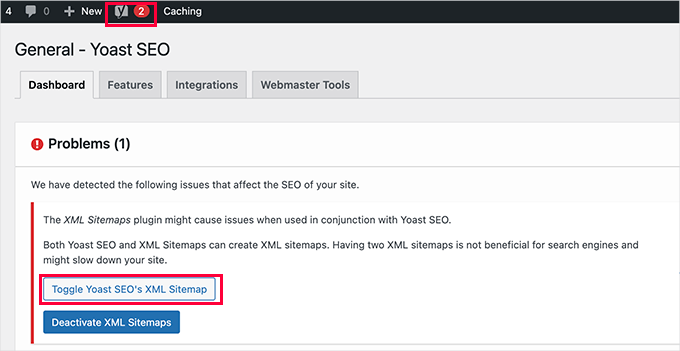
Dann können Sie auf den Button “XML-Sitemap von Yoast SEO einschalten” klicken, um fortzufahren.
Dadurch gelangen Sie auf den Tab “Funktionen” unter SEO ” Allgemein. Von hier aus müssen Sie bis zur Option “XML-Sitemaps” scrollen und sie ausschalten.

Vergessen Sie nicht, auf die Schaltfläche “Änderungen speichern” zu klicken, um Ihre Einstellungen zu speichern.
Sie können nun auf die Seite Einstellungen ” XML-Sitemap wechseln, um Ihre Sitemaps zu konfigurieren. Für die meisten Websites funktionieren die Standardeinstellungen sofort.
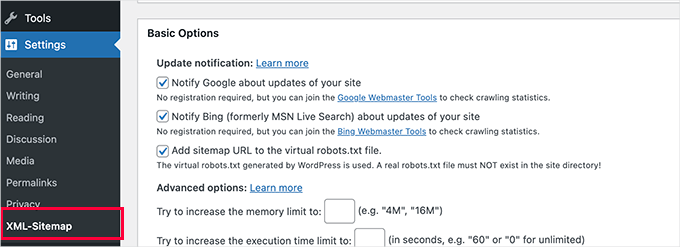
Sie können die Einstellungen jedoch jederzeit nach Ihren Bedürfnissen konfigurieren.
Sie können nun die URL der XML-Sitemap an die Google-Suchkonsole und andere Suchmaschinen übermitteln.
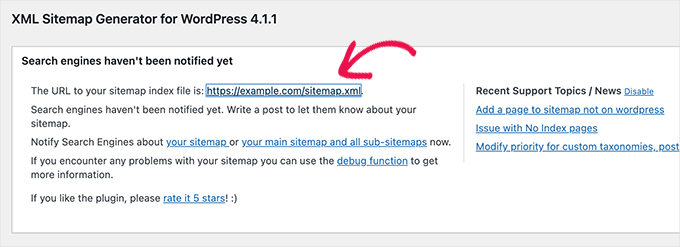
4. Wechseln Sie zum All in One SEO für WordPress
Wenn alle oben genannten Maßnahmen fehlschlagen und Sie kein separates Plugin zur Erstellung von XML-Sitemaps verwenden möchten, kann diese Methode helfen, den 404-Fehler zu beheben.
Für diese Methode benötigen Sie All in One SEO für WordPress. Es ist das beste WordPress SEO Plugin auf dem Markt und eine viel bessere Alternative zu Yoast SEO.
In unserem Vergleich zwischen Yoast und All in One SEO finden Sie weitere Details zu den Unterschieden.
All-in-One SEO (AIOSEO) verfügt über fortschrittliche XML-Sitemaps und einfach zu verwaltende Optionen, die Ihnen die volle Kontrolle darüber geben, was Sie ein- oder ausschließen möchten.
Installieren und aktivieren wir zunächst das All in One SEO for WordPress Plugin. Weitere Details finden Sie in unserer Schritt-für-Schritt-Anleitung für die Installation eines WordPress Plugins.
Hinweis: Es gibt auch eine kostenlose Version von All in One SEO für WordPress, die die meisten Funktionen der XML-Sitemap mit Ausnahme von Videos und Nachrichten enthält.
Nach der Aktivierung wird das Plugin Sie durch einen Einrichtungsassistenten führen. Wenn Sie bei der Einrichtung Hilfe benötigen, folgen Sie unserer Anleitung zur korrekten Einrichtung des All in One SEO Plugins für WordPress.

All in One SEO ermöglicht Ihnen auch den Import von SEO-Daten aus Yoast SEO.
Dadurch wird sichergestellt, dass alle Ihre bisherigen SEO-Meta-Tags und Titel unverändert bleiben.

Nach der Ersteinrichtung können Sie auf die Seite All in One SEO ” Sitemaps gehen, um die XML-Sitemap-Einstellungen zu konfigurieren.
Sie können auf den Button “Sitemap öffnen” klicken, um zu sehen, ob der 404 Fehler in WordPress behoben wurde.

Danach konfigurieren Sie die Sitemap-Einstellungen, falls erforderlich.
Bei All in One SEO können Sie zum Beispiel auswählen, was in Ihre Sitemaps aufgenommen werden soll. Sie können Beitragstypen, Taxonomien, einzelne Beiträge und Seiten hinzufügen oder entfernen.
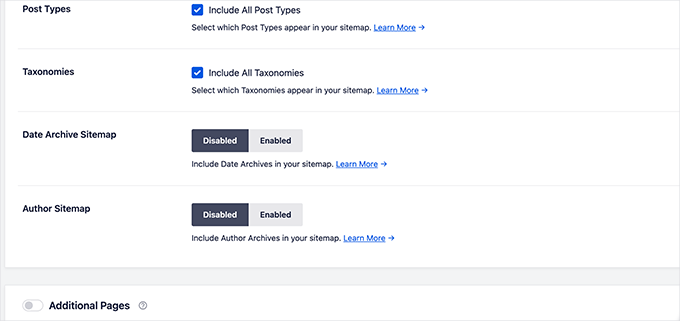
Mit All in One SEO können Sie auch Videos, Nachrichten, RSS-Sitemap und HTML-Sitemap für Ihre Website erstellen.
Erkunden Sie einfach die Tabs, um zu sehen, ob Sie weitere Einstellungen vornehmen möchten.
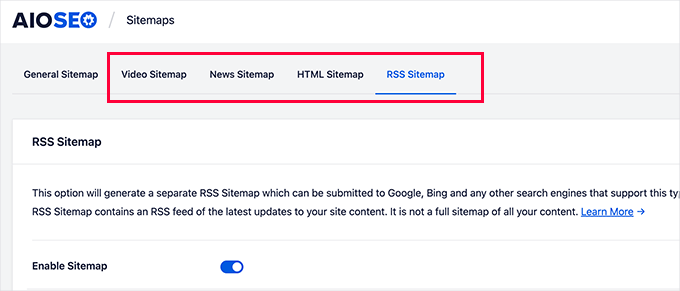
Diese Sitemaps können auch an Google Search Console und andere Suchmaschinen übermittelt werden. So können Suchmaschinen neuere Inhalte auf Ihrer Website schnell finden.
Experten-Tipp: Sie wollen diesen WordPress-Fehler nicht selbst beheben? Kein Problem – wir helfen Ihnen dabei! Verabschieden Sie sich von frustrierenden Fehlern und konzentrieren Sie sich wieder auf das, was Sie lieben. Überlassen Sie uns den technischen Kram und buchen Sie jetzt unseren WordPress-Notfallsupport!
Wir hoffen, dass dieser Artikel Ihnen geholfen hat, den Yoast SEO Sitemap 404 Fehler in WordPress zu beheben. Vielleicht interessiert Sie auch unsere Anleitung, wie Sie die Standard-Sitemap von WordPress deaktivieren können, oder unsere Expertenauswahl der besten Werkzeuge zur Optimierung von Online-Inhalten für WordPress.
Wenn Ihnen dieser Artikel gefallen hat, dann abonnieren Sie bitte unseren YouTube-Kanal für WordPress-Videotutorials. Sie können uns auch auf Twitter und Facebook finden.





Reyhan Emilia
Thank you because yoast had brought me to an impossible point. I will always read your blogs. You are perfect.
WPBeginner Support
You’re welcome, glad we could help!
Admin
Scott Baranek
Thank you so much for this article!!! I have been speaking with multiple people and support teams and I always knew it was something easy. Article was broken down for easy understanding as well. Thank you!!!
Mark the martian
Thanks so much for explaining. Was pulling my hair out over this.
WPBeginner Support
Glad our guide was helpful
Admin
ahmed
try to delete caches after first solution and it will work
WPBeginner Support
Thanks for sharing your recommendation
Admin
Deepak kumar
Due to this tutorial. My issue fix thankyou so much………..
WPBeginner Support
You’re welcome, glad our guide could be helpful
Admin
Adam
I was getting the same 404 error and the first solution solved the issue for me.
Many thanks!
WPBeginner Support
You’re welcome, glad our guide was helpful
Admin
Binod Raj Joshi
Hey, wpbeginner, I was in sitemap trouble from a few days, now it have been solved. Learning a lot from you guys about wp error fixing, thanks!
WPBeginner Support
You’re welcome, glad our guide could help
Admin
saurab
Hi
After moving to https from http, Sitemap address is displaying 404 error, Is it possible know the solution for this ?
Ashish Sharma
Nice pluging , but when I am creating sitmap using yoast and submitting it to webmaster it is showing 404 error for multiple urls. I searched in my site no where those urls exist. But y these are coming into sitemap I don’t understand any expert to help me
RAJEEV KUMAR
Sir, In my WordPress blog, 410 Response code error are showing in Yoast SEO’S Search Console feature. How I fix It.
seerity
Thanks, this fixed mine.
Tracy Pope
I tried to download the Yoast SEO plug in and I received this error message:
Fatal error: Call to undefined function apply_filters_deprecated() in /websites/websitename/wp-content/plugins/wordpress-seo/admin/menu/class-admin-menu.php on line 246
I now can’t get into my back end of the website at all I just keep getting this error? What can I do??
WPBeginner Support
Hi Tracy,
You need to connect to your website using FTP or File Manager app in your cPanel account. Go to wp-content/plugins/ and delete wordpress-seo folder. After that you will be able to login to your WordPress admin area and reinstall the plugin.
Admin
Amit
Hi,
To edit the .htaccess file do we need to remove the existing code and add your code
or
keep the existing code and add your code also?
Need help.
WPBeginner Support
Hi Amit,
Keep the existing code and paste the new code below it.
Admin
Keitai
hmm,
Tried every suggestion but still got a 404. somehow i can’t redirect xml html htm php file extensions.
when i try
RewriteRule ^sitemap_index.xl$ /site/index.php?sitemap=1 [L] and not
RewriteRule ^sitemap_index.xml$ /site/index.php?sitemap=1 [L]
Hence, i removed the “m”, and the redirect works but sitemap_index.xml doesn’t
Any more tips?
Carol
I did the first option and now I have an internal server error!
Tony
Thanks for listening. I got the solution cheers
WPBeginner Support
Hey Tony,
Glad to hear that you found a solution. Good luck
Admin
Tony
@wpbeginner support. I have already gotten the sitemap, the issue when I submit it to google for test it bring out an error http 404. I have read your post on how to edit .ht access file and wp seo. I have also check and unchecked the yoast plugin. But it hasn’t resolved the http 404. Please help
Tony
i just opened a new WordPress site. I have tried everything still the site app generated by yoast seo is still showing http 404 error. What do I do. The website is . please note I have edited my .htaccess file, edited wp-content/Wordpress. Pap, unchecked and checked site map settings for seo, saved permalinks. I even used a free sitemap generator upload the file via my Cpanel but still am getting the same error
WPBeginner Support
Hi Tony,
If you are unable to find Yoast SEO generated sitemap file, then it is located at http://example.com/sitemap_index.xml
Replace example.com with your own domain name.
Admin
nageswarao
hi bro my website Google XML Sitemaps not showing last 5 months (sitemap-pt-post-2016-06.xml end after not showing) and also sitemap-tax-post_tag.xml not showing how to solve my problem
Brandon Still
This worked for me, thank you!!!
Nik
Thanks! I was having the hardest time getting it to work and the first section with the .htaccess code did the trick!
Andy Johnston
Worked for me. Thank you!
Kunal Sarkar
Hi all,
I was facing the same problem while I came across this blog post. But I guess I found a better solution for non-tech guys.
You can simply install JetPack from WordPress and Activate its Sitemap functionality and disable the Sitemap of Yoast. Additionally Jetpack has a lot of essential features that I guess every WP admin should have.
Thanks,
Kunal Sarkar
Shivam
For me there is a different issue. Its just showing plain text instead of links. Can some one help please
Naman Kumar
Hey, I’m using the same code goy fixing yoast xml sitemap but what to do for google analytics by yoast?
Mohammed Jhosawa
Hi Guys,
Please follow this steps if you are facing 404 error issue with Yoast XML Sitemap :
1. Go to > Yoast SEO Plugin.
2. Yoast SEO Plugin > XML Sitemap.
3. Uncheck the user XML Sitemap functionality > Save Changes.
4. Again Check XML Sitemap functionality > Save Changes.
5. Click on XML Sitemap and you’ll see your sitemap_index.xml right there.
Hope this information is useful to you.
Thanks.
Alx Diesel
@Mohammed Your suggestion worked. Thanks a lot.
Amar
Thnks bro this worked for me.
Mr. Dif
This worked for me also although I did implement the .htacess change as well.
Mohammed
Your idea was good and thanks a lot
Faisal Sofi
It worked… Thanks
Felix
Yo here is an easy way to fix it and should work fine for all!
Go to settings in wordpress
Select permalinks
Don’t change anything
Just Press save changes at the bottom of the page
Now click on your XML Site Map button again in Yoast
404 error should no longer show
You welcome homies
Pankaj
Yah This is fixed! Thanks a lot!
Christian
thanks man, this worked.
Grant
Reply to say that this method worked for me. Just go to permalinks page in settings, and click save.
Raf
Awesome!! It worked.
Sergey
Thanx! fixed for me
Deborah
Thank you so much! Worked like a charm to reduce the number from 1000 to 100.
Tim
Simply untick “Check this box to enable XML sitemap functionality.” in the SEO plug-in and Save Changes, then renable again. Problem solved.
Arshad
Thanks Joshua
Had the same problem. Changing the rows from 1000 to 100 will fixed it for me.
Klick
Thx i have change it too from 1000 to 100 now it work Thanx
Ridfay
Now work with this tips thanx
Miro
After adding the first code to your htacces file disable sitemap functionality flush your cache (if you use any of caching tools like w3 total cache) and then enable the functionality again.
It worked for me that way.
Thank you for the tutorial! It helped!
aaron
I seem to be getting this for my posts. I suspect yoast is deleting my .htaccess file.
Jeremy Vandermeer
Unchecking and rechecking the XML SItemap option also worked for me. Thanks!
Esteban
Thank you!
Joe
Hey guys. I fixed it! I turned this sitemap option off in this flawless plugin and used a different plugin. It was that easy. It was probably my crummy theme though. Probably.
Atanas Tanev
Ok guys. I was struggling with this issus for a day or so and finally I found the solution!
Skip the mentioned plugins and the codes which may harm your website. I’ve tried everything!
Simply uncheck the “remove strip” from yoast plugin and instead of this option just download and install the plugin: “Remove Category URL” from wordpress plugin section.
The plugin supports WPML and sitemaps and the 404 error is fixed!
Now you can buy me a beer for saving all your headaches!
Cheers!
Atanas Tanev
Nirav Dave
Hey ATANAS!
No way man! This solution worked for me mate. Thank you so much for sharing this.
Nirav
Bas
i placed the code in my .htaccess file and saved it. Now every page gives a 500 internal server Error!!!
What can i do?
Jay
Same with me!!!? Have you managed to fix this?
Miles O'Brien
What I did was I went to the xml sitemap page under the SEO plugin and under user sitemap I unchecked disable user sitemap. then when I put in the sitemap into webmasters it worked successfully. I can’t help you with your 500 internal error, But if you do this fresh it should work instead of using the code.
Rafael
BAS: Remove the code you entered into your.htaccess file, resave it to the server and reload the website.
Henry
If anyone is using iThemes security plug in and has set it to guard the .htaccess file, disable it and create your sitemap, then re-enable.
Rami Alloush
Uncheck then re-check indeed solved that for me.
Thanks
Chris
LOL This worked for me too. I looked at 25 pages before I saw your comment.
Nikos Kavvadas
I add the code in the .htaccess and then i uncheck the sitemap option in the Yoast’s SEO plugin and save their settings. After that i re-checking the sitemap’s option and the the error is solved!
Thanks!
Henk Valk
Thanks Joshua
Had the same problem. Changing the rows from 1000 to 100 will fixed it for me.
Morteza
Thanks a lot, but not works for me. I do all of these ways and check/save/uncheck/save/XML Sitemap process after one & both of them… but ERROR 404!
I’ll try another plugins for this.
thanks for your great site..
Gaurav k
yeah this one is a great finding thanks a lot
TimValDen
Worked for me too… I had the 404page problem when loading the sitemap generated by Yoast SEO.
Joshua Largent
This is what worked for me – Go to the yoast XML sitemap on your dashboard. Change the Max Entries per sitemap from 1000 to 100. Worked like a charm for me.
Tony
Easy does it again, change from 1000 to 100 did the job, without changing the code. Thank You!
onarto
It looks like htaccess edition disappear since yesterday… nothing in the menu anymore…
Adrienne McCue
Just checking and unchecking takes care of the issue. I will check this plugin out now! I did so much seo before, but I like so many features here!
David Bell
I found the same thing as Jane below. Thank you!
smaug
adding the following code to my .htaccess fixed the sitemap for me:
https://gist.github.com/jdevalk/5345872
(note this code is for if your wordpress installation is in a subdirectory named wordpress, if your is in a different folder, change the directory name in the code)
Awais
i have photography website . Should i uncheck the exclude media option or it’s ok?